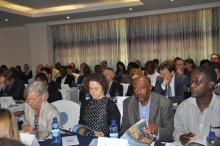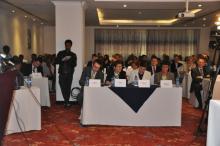Joint plans launched for response to drought, malnutrition and disease outbreaks in Ethiopia
ADDIS ABABA, 11 December 2015 | The World Health Organization (WHO) is working alongside the Ethiopian Ministry of Health and 22 partner organizations to respond to the health needs of 3.6 million people vulnerable to health and nutrition emergencies due to the El Niño weather phenomenon. Humanitarian partners came together in Addis Ababa, Ethiopia, today to launch joint plans for the crisis response in 2016.
“This is a natural disaster on a scale that would be difficult for any government, anywhere, to manage,” said Dr Paul Mainuka, acting WHO Representative for Ethiopia. “But our colleagues in the Ministry of Health are showing remarkable leadership and commitment to the response. Their efforts over the years to strengthen the health system, down to the community level, will help ensure that we can reach the men, women and children who are affected by this crisis in time."
“We're here to assist the Ministry, at their request, but they are certainly pulling out all the stops to minimize the impact of the crisis, including redeploying health staff to the worst-affected areas, sending medicines, distributing bed nets and vaccinating children for measles," confirmed Dr Anne Ancia, WHO’s Health Emergency leader. "That’s in addition to everything they are doing to prevent further deterioration of the nutrition situation.”
The El Niño weather phenomenon has triggered drought in large parts of Ethiopia and flooding in others, causing crops to fail. As a result, malnutrition is on the rise and, with it, the population’s vulnerability to disease outbreaks. Malnourished people are both more susceptible to disease outbreaks and suffer more severely when infected. Even normally mild infections can become deadly. Ethiopia has already witnessed outbreaks including dengue fever, acute watery diarrhoea, scabies and meningitis, situations that could possibly worsen with the current weather phenomenon.
“The World Health Organization is one of our longest-serving friends,” said Dr Daddi Jima, leader of emergency response at the Ministry of Health at the Ethiopian Public Health Institute. “WHO has been a steadfast partner in supporting our efforts to strengthen the health system and increase its resilience to crises. Now we’re faced with an emergency situation where rapid response and good preparedness is required. We’re glad to have WHO here, by our side.”
According to the newly released Humanitarian Requirements Document for Ethiopia, health partners will work together in 2016 to tackle disease outbreaks and ensure those affected can access life-saving health care.
One interesting initiative, for example, is the “EWARS in a box” project being put forward by WHO. If funded, this project will enable the real time monitoring of the spread of communicable diseases and rates of malnutrition through the use of mobile technology, providing valuable data to guide the rapid response of both health and nutrition partners.
“However, while we want to be able to provide strong support to the Ministry of Health and the people of Ethiopia, we’re constrained by the fact that we are currently lacking funding,” Dr Ancia continued. “We’re asking the international community to please provide the US$ 9.5 million we need to respond quickly and effectively. Let’s work together to prevent this crisis from escalating further.”
Read the full HRD Report: Ethiopia Humanitarian Response Document 2016
For more information, please contact:
Lauren O'Connor
External Relations Officer
WHO HQ
oconnorl [at] who.int (oconnorl[at]who[dot]int)
+41792907844
+251 967 528 413
Loza Mesfin
Communications Officer
WHO Ethiopia
tesfayel [at] who.int (tesfayel[at]who[dot]int)
+251 911 144 194







